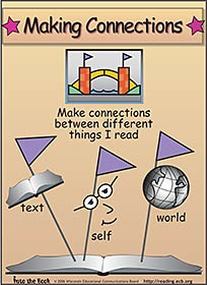What is Making Connections?
According to Into the Book (2015), good readers make connections as they read. They can relate the book to their personal experiences (text-to-self), to information from other texts (text-to-text), or from what they know about the world (text-to-world). Making connections is linking what the students read, to what they already know. This strategy helps students comprehend text, by activating their prior knowledge and making meaning of what they read. Debby Draper (2012) suggests questions that students may ask themselves as they read to help them make connections with the text. The questions are listed below.
Text-to-Self
These are great questions that students can ask themselves to become better readers. Making connections allows readers to actively engage in their reading, by relating to the text.
Text-to-Self
- What does this remind me of in my life?
- How is this different from my life?
- How does this relate to my life?
- What were my feelings when I read this?
- What does this remind me of in another book I've read?
- How is this text similar/ different to other things I've read?
- Have I read about something like this before?
- What does this remind me of in the real world?
- How is this book similar/ different to things that happen in the real world?
- How did that part relate to the world around me?
These are great questions that students can ask themselves to become better readers. Making connections allows readers to actively engage in their reading, by relating to the text.
Visual Representations
Content Area Examples
Math- Making connections could be adapted in a math lesson by having the students connect what they are learning in math to real life situations. Often times, students may think that math is a waste of time because they will never use it in the real world. If students are learning about money, give them real life problems that they can relate to. For example, if John buys a video game for $8.52 and he pays with a $10 bill, how much money will he get back. It is important to use real world problems so the students can connect to the math. It gives math a purpose and helps students comprehend what they are learning.
Reading- This strategy is used in reading quite often. Teachers may provide their students with a graphic organizer to help them make their connections as they read. Making connections during reading helps students with comprehension. For example, in the video above, there is a student who was reading a book about dogs. The students recommended that book to her friend because she knows her friend likes dogs. The friend really enjoyed reading the book because she could relate to it. She was able to better comprehend what she was reading because she was interested in it.
History- This strategy could be adapted into a history lesson by having the students read a chapter and then talk about how they can relate to what they had just read. For example, if there is a unit on where we come from, the students can talk about where they come from, and all of the places they have lived. Some students may have moved many times, and other students may have lived in one house their whole life. Some students were born in other countries, while other students were born in their city. This is a great way for the readers to connect to what they are reading about. By making connections to the texts helps readers better comprehend the material or what is being taught.
Science- Making connections could be adapted in a science lesson in so may ways. The teacher may assign the students a text on recycling, for example. Students can connect to this because they throw away garbage just about every day. Students need to understand the importance of recycling and the effects it has in the world. If readers are reading a text about what should be recycled, they may make a text-to-world connection, and pay more attention to what they throw in the garbage and what should be recycled.
Reading- This strategy is used in reading quite often. Teachers may provide their students with a graphic organizer to help them make their connections as they read. Making connections during reading helps students with comprehension. For example, in the video above, there is a student who was reading a book about dogs. The students recommended that book to her friend because she knows her friend likes dogs. The friend really enjoyed reading the book because she could relate to it. She was able to better comprehend what she was reading because she was interested in it.
History- This strategy could be adapted into a history lesson by having the students read a chapter and then talk about how they can relate to what they had just read. For example, if there is a unit on where we come from, the students can talk about where they come from, and all of the places they have lived. Some students may have moved many times, and other students may have lived in one house their whole life. Some students were born in other countries, while other students were born in their city. This is a great way for the readers to connect to what they are reading about. By making connections to the texts helps readers better comprehend the material or what is being taught.
Science- Making connections could be adapted in a science lesson in so may ways. The teacher may assign the students a text on recycling, for example. Students can connect to this because they throw away garbage just about every day. Students need to understand the importance of recycling and the effects it has in the world. If readers are reading a text about what should be recycled, they may make a text-to-world connection, and pay more attention to what they throw in the garbage and what should be recycled.


